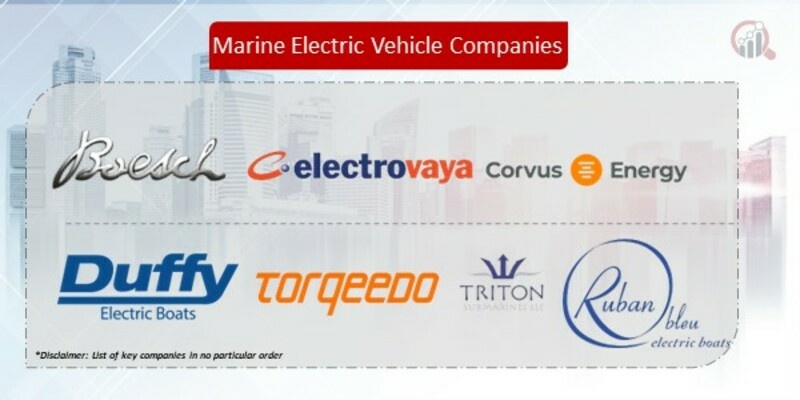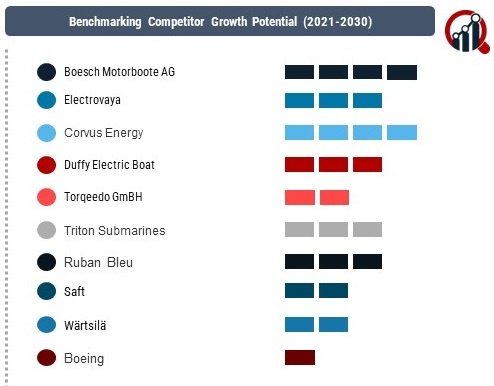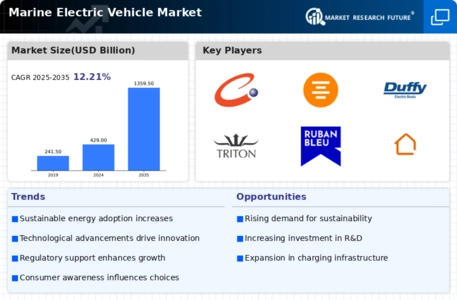Top Industry Leaders in the Marine Electric Vehicles Market

Key Players and Market Share Analysis
Boesch Motorboote AG (Switzerland)
Electrovaya (Canada)
Corvus Energy (Canada)
Duffy Electric Boat (US)
Torqeedo GmBH (Germany)
Triton Submarines (US)
Ruban Bleu (France)
Saft (France)
Wärtsilä- (Finland)
Boeing (US)
Andaman Boatyard (Thailand)While these established players continue to dominate, new entrants and emerging companies are making noteworthy strides. Companies like Torqeedo GmbH, Zero Emission Industries, and Echandia Marine are gaining recognition for their innovative electric propulsion technologies, signaling a shift towards a more diversified competitive landscape.
Strategies Adopted by Key Players
In the race for supremacy, key players in the Marine Electric Vehicle market are adopting multifaceted strategies to stay ahead. ABB Ltd. has focused on strategic collaborations and partnerships, strengthening its position by aligning with shipbuilders and maritime industry leaders. Siemens AG, on the other hand, has emphasized research and development, consistently introducing advanced electric propulsion systems that cater to the evolving needs of the marine sector. Wärtsilä Corporation's strategy revolves around a holistic approach, offering end-to-end solutions that encompass not only electric propulsion but also energy storage and integration services.
New and emerging companies are employing innovative strategies to disrupt the market. Torqeedo GmbH, a pioneer in electric boating, has emphasized product differentiation by introducing high-performance electric outboard motors. Zero Emission Industries, with a focus on hydrogen fuel cell technology, aims to provide sustainable propulsion solutions for maritime applications. Echandia Marine stands out by concentrating on modular battery systems, offering scalable solutions tailored to various vessel types.
Factors for Market Share Analysis
Several factors contribute to the analysis of market share within the Marine Electric Vehicle sector. Technological innovation, product differentiation, geographic presence, and strategic partnerships play pivotal roles. The ability to offer comprehensive solutions, encompassing electric propulsion, energy storage, and intelligent control systems, is a key determinant of market share. Additionally, the adaptability of these solutions to different vessel types, from small boats to large ships, is crucial for market penetration.
Market share analysis also considers a company's commitment to sustainability and its alignment with international regulations and emissions standards. Companies actively investing in research and development to enhance efficiency, reduce carbon footprint, and improve the overall environmental impact of maritime transport are likely to gain a competitive edge.
New and Emerging Companies
The Marine Electric Vehicle market is witnessing the emergence of innovative startups poised to disrupt the status quo. SeaBubbles, for instance, is exploring the potential of electric hydrofoil boats for urban transportation, aiming to revolutionize water-based mobility. Zunum Aero, while primarily focused on electric aviation, is also venturing into electric propulsion for small regional electric aircraft that could extend their application to maritime transport.
These new entrants bring fresh perspectives and technologies to the table, challenging traditional players and encouraging the industry's evolution towards more sustainable and efficient solutions.
Industry News and Current Trends
The Marine Electric Vehicle market is abuzz with industry news and current trends that underscore the ongoing transformation. One significant trend is the increasing adoption of hydrogen fuel cells for marine propulsion. Companies like Ballard Power Systems and Plug Power are actively exploring and implementing fuel cell technologies to power electric vessels, offering a cleaner alternative to traditional fossil fuels.
Another noteworthy development is the integration of artificial intelligence (AI) and automation in electric propulsion systems. Companies are leveraging AI to optimize energy consumption, enhance navigation, and improve overall operational efficiency. This integration not only aligns with the broader trend of digitization in the maritime industry but also positions these companies as pioneers in smart and sustainable marine transportation.
Current Company Investment Trends
Investment trends in the Marine Electric Vehicle market highlight the industry's attractiveness to investors seeking opportunities in the transition to sustainable transportation. Venture capital firms and strategic investors are increasingly backing companies with promising technologies and innovative solutions. Notable investment areas include battery technology, electric propulsion systems, and hydrogen fuel cell development.
Additionally, governments and international organizations are actively supporting the transition to electric propulsion in the maritime sector. Incentive programs, grants, and subsidies for research and development are encouraging companies to invest in sustainable technologies. This influx of funds is fostering the growth of the Marine Electric Vehicle market and supporting the scaling up of production capabilities.
Overall Competitive Scenario
The overall competitive scenario in the Marine Electric Vehicle market is characterized by a delicate balance between established industry giants, innovative startups, and the ongoing wave of technological advancements. While key players maintain their dominance through strategic partnerships and comprehensive offerings, new entrants are disrupting the market with specialized solutions.
The industry's future hinges on the collective ability to address challenges such as infrastructure development, energy storage efficiency, and regulatory frameworks. Companies that successfully navigate these challenges, align with sustainability goals, and adapt to the evolving landscape are poised to lead the charge towards a greener and more efficient future for maritime transportation. As the demand for clean energy solutions intensifies, the Marine Electric Vehicle market is set to witness further innovation, competition, and transformative growth in the coming years.
Recent News :Top of Form
ABB Ltd., for instance, has excelled in offering electric propulsion and energy storage solutions for marine applications. Siemens AG, a renowned name in electrification and automation, has carved a niche by providing cutting-edge electric propulsion systems. Wärtsilä Corporation, with its comprehensive portfolio of marine solutions, has secured a substantial market share.
Siemens
October 26, 2023: Siemens received an order from a Chinese shipyard to supply its BlueVault battery system for a hybrid-electric ferry operating in Norway. This marks the first commercial application of Siemens' BlueVault technology in the ferry segment.
ABB
December 12, 2023: ABB unveiled its latest Azipod propulsion system specifically designed for electric and hybrid vessels. The new system offers improved efficiency, maneuverability, and noise reduction compared to traditional propeller
Volvo Penta
November 8, 2023: Volvo Penta launched its fully electric drivetrain system for high-speed craft. The system is available in two power outputs and can be used for a variety of applications, including passenger boats, water taxis, and patrol vessels.
Kongsberg Maritime
October 31, 2023: Kongsberg Maritime announced a partnership with Damen Shipyards to develop and build a fleet of autonomous electric cargo vessels. The project aims to demonstrate the feasibility and commercial viability of autonomous MEVs for short-sea transportation.
Wärtsilä
September 27, 2023: Wärtsilä signed a contract to supply its hybrid propulsion system for two new research vessels being built for the University of Hamburg. The vessels will be used for scientific research in the Baltic Sea and will feature Wärtsilä's innovative energy storage and management solutions.










